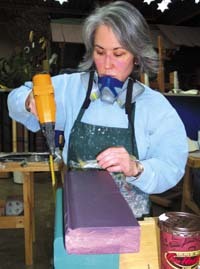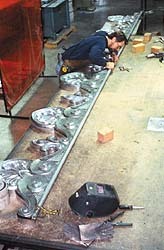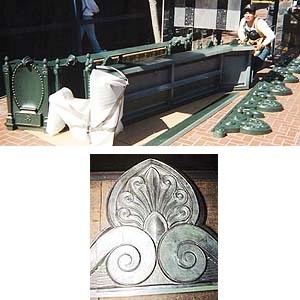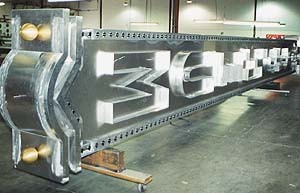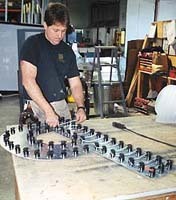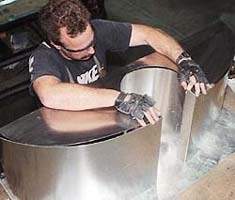Even with the millennium approaching and the increasing convenience of in-home entertainment, the Internet and MTV, theaters still exist — and thrive. In fact, there seems to be a revival of stage plays and Broadway musicals. The arts are once again considered fashionable, and major cities are reviving theater districts and opening restaurants to cater to this newfound interest. Many arts patrons are even attempting to restore the spirit of old-time theaters by renovating existing venues rather than tearing them down.
Such is the case with San Francisco’s historic Orpheum Theatre. The Orpheum, situated on the corner of Hyde and Market Streets, first opened its doors more than 72 years ago. Originally named the New Pantages Theatre after Alexander Pantages, an entrepreneur who owned a string of theaters, the venue housed vaudeville productions.
With a modest budget of $1 million, Pantages designed the theater interior with a vaulted ceiling painted to resemble a clear, night sky and mythical figures reminiscent of pre-Reformation Spain. The building’s facade, patterned after a 12-century French cathedral, featured an electric blade sign and accompanying marquee. When it opened in 1926, the Pantages was truly a spectacular venue. Unfortunately, vaudeville’s popularity lasted only a few years, and the Pantages was sold, renamed the Orpheum Theatre, and reopened to show movies.
In 1970, live theater returned to the venue when the Orpheum presented the musical Hair. But in 1981, the theater was forced to again close its doors. That same year, however, the Shorenstein Hays Nederlander Organization, under the vision of Carole Shorenstein Hays, bought the Orpheum, and theater once again returned. To bring Broadway-caliber productions to the San Francisco theater, the new owners funded a $20 million renovation in 1997, which was completed in March 1998.
In addition to the extensive interior renovation, the Orpheum received some brand-new exterior signage. To mimic the theater’s original facade, the owners ordered new signage with a design straight out of the 1920s. San Francisco-based Toll Architectural Graphics Inc. was contracted to create the signage, and then joint-ventured the design, fabrication and installation with Superior Sign Systems, a full-service signshop based in Vacaville, CA. Toll Architectural President Dean Toll and Superior Sign Systems Sales Executive Bob Riddell worked together to make the project a reality.
A unique project
To generate an initial concept for the Orpheum’s new signage, the Shorenstein Hays Nederlander Organization obtained original black-and-white photographs of the Pantages Theatre’s facade for reference. Superior Sign Systems and Toll Graphics then worked with the owners to develop computerized conceptual drawings that would restore the look of the theater’s original signage, but with a custom font and suitable materials. As such, Superior Sign Systems and Toll Graphics were able to design a completely modern sign — one that incorporates vinyl and digitally printed signage — but in a decidedly retro style.
Superior Sign Systems’ Chief Designer Sid Aslami single-handedly designed the three main exterior signs: a blade sign, two show panels and a marquee sign. Although the company has been producing electric signage for 13 years, Aslami says, "This project was a very unique opportunity for us." It was unique not only due to its vastness, but because the company was given a 30-day deadline to fabricate and install the entire sign project before the design was complete.
The show panels
Showcard panels have historically played an important role in exterior theater signage. But the showcard-panel portion of the Orpheum project combined tradition with a decidedly modern twist — digitally printed posters. The two show panels, measuring 8 feet by 11 feet by 1 foot, are fabricated from .125-inch aluminum with a galvanized-steel framing support. Each 8-foot-square, internally illuminated cabinet features a removable Lexan
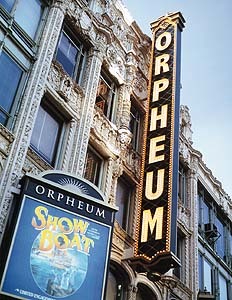

 Tip Sheet3 days ago
Tip Sheet3 days ago
 Business Management1 week ago
Business Management1 week ago
 Women in Signs2 weeks ago
Women in Signs2 weeks ago
 Real Deal4 days ago
Real Deal4 days ago
 Editor's Note1 week ago
Editor's Note1 week ago
 Maggie Harlow2 weeks ago
Maggie Harlow2 weeks ago
 Line Time2 weeks ago
Line Time2 weeks ago
 Product Buying + Technology1 week ago
Product Buying + Technology1 week ago

